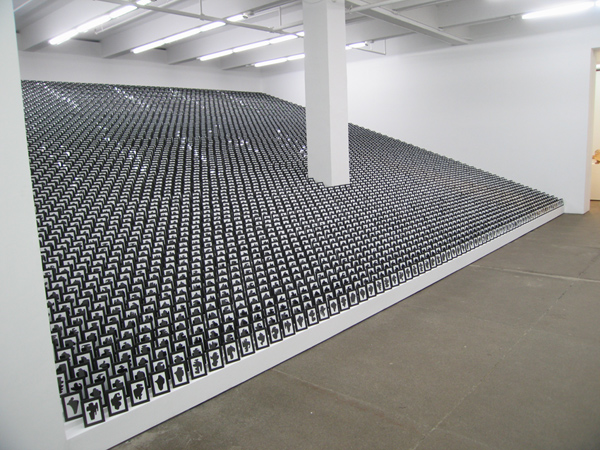 Allan McCollum. The SHAPES Project, 2005/06. 7,056 SHAPES Monoprints, each unique. Framed digital prints, 4.25 x 5.5 inches each. Installation: Friedrich Petzel Gallery, New York.
The Illusion
Last fall, at a small gallery on West 22nd Street in New York, the artist Allan McCollum exhibited his new system for producing unique two-dimensional shapes. Developed using vector files on his home computer, McCollum organized a "system" to produce over 31,000,000,000 different shapes and has, to date, set aside 214,000,000 for creative experimentation. But that's not all. McCollum aspires to an unprecedented scale with this system: his goal is to make enough shapes, assuming a population of approximately 9.1 billion by the year 2050, so that everyone on the planet can have one. The shapes notwithstanding, what is it about systems that we love to hate — and hate to love? McCollum, who turns 63 this year, has a long-standing interest in formal replication, and his work frequently addresses questions of materiality and value. (His installations lead one to rapidly conclude that the lofty promises of modernism aren't likely to be fulfilled anytime soon: here in McCollum's orbit, more = less.) He also possesses the entrepreneurial spirit that has come to characterize a number of contemporary artists who think pluralistically about making work. His shapes, for example, can be used for many different purposes, "not only for fine art and design projects," notes his gallery's press release, "but also for various social practices: as gifts, awards, identity markers, emblems, insignias, logos, toys, souvenirs, educational tools and so forth." The relationship between shapes and social practices is, at its core, an essential design conceit — from typographic identity to architectural megastructure, giving form to ideas is what designers do. But McCollum's project goes beyond mere morphology, embracing a kind of über-solution in its very claim. Endlessly permutable, teeming with indefinite potential, McCollum's strategic genius lies in his appeal to a culture hungry for the quick fix. The Shapes Project promises maximum gain with minimum effort: better living through geometry.
It also shares a kind of loose ancestry with a host of Nineteenth-Century modular systems — anchor blocks, Froebel blocks — once widely used as educational tools to teach the essential principles of geometry. At the same time, it offers a kind of 21st-century spin on the Tangram, an ancient Chinese dissection puzzle, which divides a square into seven pieces — five triangles, a rhombus and a square — from which countless variations can be produced. (Pieces can touch and connect, but may not overlap.) Like an alphabet, tangrams represent a system that's fundamental and fixed, yet allows for seemingly endless variation. But unlike the alphabet, shape systems like the tangram are essentially mathematical: anchored by numerical certainty, they allow for infinite permutation. Which brings us back to McCollum's epic endeavor — and here, it's not so much the shapes themselves as the idea of the shapes, the very notion of a system of forms that's so captivating. And so unnerving. If I were to identify the one prevailing topical interest that has most surfaced in the last year — among students, in juries, at conferences and exhibitions — it would have to be this obsession with series and systems. How to identify them; how and where to introduce them; the question of whether, once a series is identified, your work is done. It's the illusion of certainty that's so mesmerizing — the idea that not everything is in flux, unfixed and mashed-up and dislocated. Systems by their very nature introduce an armature as well as a roadmap for their own completion. You look at one iteration, then two — then ten — and you get it. Once demystified, you can concentrate on other things — form, perhaps, or beauty. A glorious insect. A Trollope poem. Your lunch. Or not. Which begs the question: does a system invite psychological repose precisely because it is so clear and comprehensible — or does it lead us to search for precisely its opposite — a kind of exotic deviation from the norm, an abstraction or glimmer of novelty? McCollum stresses that he laboriously created each of these shapes, and resists the notion that this body of work emerged from a kind of robotic (read "vector generated") process. Is artistry compromised if software is involved? Is design? Regardless of how and where he produced each variant, it's clear that The Shapes Project has defined parameters and a prognosis for growth: it may be dull, repetitive, or even inversely proportionate to what you think of as original, but to many designers, it's also oddly reassuring. (And oddly parallel to the design process, which by its very nature is systems-reliant.) And there's the rub: the rational side of our brains leads us to such solutions because they gesture to an odd kind of certainty. That tension — between structure and freedom, between form and its variation — is an essential characteristic of design thinking. That it took an artist to make it gallery-worthy is at once galling and brilliant. Better living through geometry, indeed. |
